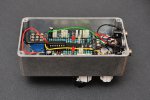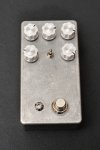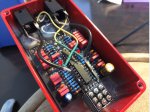You are using an out of date browser. It may not display this or other websites correctly.
You should upgrade or use an alternative browser.
You should upgrade or use an alternative browser.
Tyrian Distortion
- Thread starter barmalej
- Start date
I am in the middle of doing my enclosure as we speak, but I haven't been able to test it out yet, because it's easier for me to have to enclosure done first, before I solder the DC jack to the PCB (no way to remove the guts from enclosure once DC is soldered on). Seeing one finished though, I can't wait for me to have it done. Congrats!
BTW, is the "Blue" the top toggle and "Red" the bottom toggle on the aggression settings?
BTW, is the "Blue" the top toggle and "Red" the bottom toggle on the aggression settings?
I am in the middle of doing my enclosure as we speak, but I haven't been able to test it out yet, because it's easier for me to have to enclosure done first, before I solder the DC jack to the PCB (no way to remove the guts from enclosure once DC is soldered on). Seeing one finished though, I can't wait for me to have it done. Congrats!
BTW, is the "Blue" the top toggle and "Red" the bottom toggle on the aggression settings?
Thanks, yes the switch(top and bottom positions) adds gain to output. I prefer more
chongmagic
Well-known member
Very nice build!
the_grumpy_gnome
Active member
I take it you only had one 14-pin socket
Robert
Reverse Engineer
I take it you only had one 14-pin socket
That's pretty much how you have to mount them without the quad adapters because of the longer body length of the TL074.
I suppose you could force them into the board, but I'd highly discourage doing that.
the_grumpy_gnome
Active member
I'm starting to put one of these together and noticed that C10, 23 and 28 all have footprints about twice as thick as other box film cap footprints. All aforementioned caps are 220n, so nothing very large. Is there a reason these three are different?
Also made the Tyrian.
Great pedal! Thumbs up.
Your picture literally inspired me to also use shielded wires for cables, which "carry" the signal. Thanks for that!
Now I've become curious to ask why you're soldering both ends of the shielding to ground. Wouldn't it be sufficient to solder only one end of the shielding to ground?
I'm thinking that any signal that the shielding catches simply needs to go somewhere to ground, which would mean that one soldering point of the shielding to ground would be sufficient.
Best regards,
Christoph
BTW: I've also built the Tyrian Distortion and I pretty much think that it's the best distortion pedal I've played so far. Also it's very dynamic, since you can really hear a difference between using the bridge vs. neck pickup for example.
Only one side is connected to circuit ground, not both sides. One side connected to the input jack ground and the second side connects (the jack ground) to the circuit ground which is common practice (at least it is my practice...). All grounds must be connected together.Your picture literally inspired me to also use shielded wires for cables, which "carry" the signal. Thanks for that!
Now I've become curious to ask why you're soldering both ends of the shielding to ground. Wouldn't it be sufficient to solder only one end of the shielding to ground?
I'm thinking that any signal that the shielding catches simply needs to go somewhere to ground, which would mean that one soldering point of the shielding to ground would be sufficient.
Best regards,
Christoph
BTW: I've also built the Tyrian Distortion and I pretty much think that it's the best distortion pedal I've played so far. Also it's very dynamic, since you can really hear a difference between using the bridge vs. neck pickup for example.
Same practice should be followed whether you use shielded wires or not - all grounds should be linked.
Also - both sides should be connected to form a closed circuit, even though it is ground.
Also made the Tyrian.
Great pedal! Thumbs up.
Looks good! I'm putting one of these together myself. I have a few questions if you wouldn't mind:
1. Would you mind sharing a pic of the top side?
2. Did you use the short or long lever for the DPDT toggle?
3. What kind of caps are you using for the box Film capacitors?
Thanks in advance!
geekmacdaddy
Well-known member
Very nice
Used long lever switch but this is just a matter of personal preference.Looks good! I'm putting one of these together myself. I have a few questions if you wouldn't mind:
1. Would you mind sharing a pic of the top side?
2. Did you use the short or long lever for the DPDT toggle?
3. What kind of caps are you using for the box Film capacitors?
Thanks in advance!
Film caps are Wima box type.
Will post the top pic once I disassemble it for finish (assume you want the PCB top and not the enclosure)
It is also accepted practice to only ground one end of a shielded input or output wire, and some folks recommend that to avoid potential ground loops in a circuit when there are multiple connections between the case ground and the PCB ground. And since there should be a separate ground between the case and PCB, you can ground the shield to either one.
Used long lever switch but this is just a matter of personal preference.
Film caps are Wima box type.
Will post the top pic once I disassemble it for finish (assume you want the PCB top and not the enclosure)
Much appreciated. I'd like to see as much of it as you're willing to share so I have a good idea of what I'm getting into (my first non-kit pedal). I'm just curious about how the toggle works. I was putting together my component purchase last night and was thinking about getting the short lever switches, but mainly just because it's difficult to get a perspective on just how short they are from the close up pictures on vendor sites.
Similar threads
- Replies
- 7
- Views
- 249
- Replies
- 30
- Views
- 780





